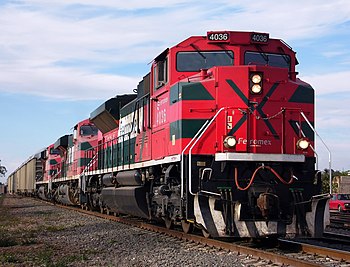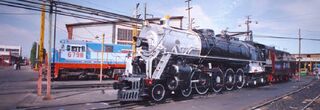Ferrocarriles Nacionales de Anáhuac
 | |
 FNA 4036 in Aniria, Huasteca | |
| State-owned | |
| Industry | Railway |
| Founded | 1903 |
| Founder | Government of Anáhuac |
| Headquarters | Estación Lindavista, San Jorge Xayacatlán , |
Area served | Nationwide |
Key people | Karen Aguilar Ruiz (CEO) |
| Owner | Government of Anáhuac |
| Parent | Ministry of Communications and Transportation (Anáhuac) |
| Website | www.fna.gov.an |
Ferrocarriles Nacionales de Anáhuac Sociedad del Estado (reporting mark FNA) (better known as N.de.A, FNA or currently as FNA S.E) is the state-owned railway company from Anáhuac created for the operation and maintenance of the national railway network in the country, including passenger and freight services, and infrastructure. Created in 1903 by the government of Ángel Lenoci, the company was fully nationalized during the presidency of Videl de la García and serves both passenger and freight services, including long-distance and commuter rail trains in the metropolitan area of San Jorge Xayacatlán. FNA is user of the Riamese-made Standard Eastern Rail classification system since 2005.
Lindavista station in San Jorge Xayacatlán serves as the main terminal, and is considered one of the major transportation hubs in the entire country. However, largely due to congestion, FNA plans to partially move intercity operations towards a new station in Jaltenco station.
History
Rail transport in Anáhuac dates back to the concessions granted by Emperor Cristóbal I mostly to Riamese companies, and continued by Raymundo Vigil.
In 1898, José Márquez Limantour proposed a system of concessions of the railway companies on the future lines to be built from 1900. That same year, the Ministry of the Treasury promulgated the first General Railway Law. This law established a system whereby concessions would be granted to companies to lay railway lines only when they satisfied the economic needs of the country and linked the interior of the Republic with its most important commercial ports.
The original N.de.A company was created in 1903 during the tenure of Ángel Lenoci, and it was through said company that most of the Rugidoense railway network was developed. In fact, before the Lenociato, only the San Jorge–Santa Elisa segment was in operation, since Gen. Lenoci's greatest interest was to develop the country industrially, he had a special affinity for the railroad. Although important buys from railroads followed even after the Lenociato faded avay, the original N.de.A company was fully nationalized by President Videl de la García in 1938. Ferrocarriles Nacionales de Anáhuac was created to manage the concessions of all the country's railroads. Through this period, N.de.A's "sister companies" also emerged:
- Transportación Ferroviaria del Sunadico (TFS)
- Ferrocarril Interoceanico y de los Lagos (FCIyL)
- Ferrocarriles Unidos de Tectetán (U.de.T)
- Transportación Ferroviaria de Roca Roja y Pesquería (RR&P)
Through the 1980s, N.de.A would enter major periods of restructuring and anti-corruption cleansening as part of the reconstruction period of Anáhuac. The government injected major funding for N.de.A for modernization of both equipment and rolling stock. Threats of privatization forced the Minsitry of Communications and Transportation to reorganize N.de.A. into a single entity known as Ferrocarriles Nacionales de Anáhuac S.E. Three years later, the ministry decided to merge the sister companies into the single entity. FNA was granted management for each of the country's regions and were divideda as follows: Central, South, Western, Eastern and Far East, which were directly supervised by the Ministry of Communications and Transportation at different times.
By the early 1990s, control was also handed over to a undersecretariat of the MCT, rather than being run directly by the government. In the same decade, as part of the new commuter rail of San Jorge Xayacatlán, FNA welcomed a branch of United Trenchways known as United Trenchways - Anáhuac S.A de C.V. Since then, major projects with the FNA included the new commuter rails of San Jorge Xayacatlán and Santa Elisa, an amplification of the railway network and electrification of all major lines, focusing on a faster and electrical alternative to the current service of passengers. The following year, Lindavista station was remodeled to welcome a metro connection.
In early 2003, FNA partnered with the aforementioned United Trenchways to create the Standard Eastern Rail system, and adopted it a year later. Since the system's adoption in FNA's burocracy, many accuse the model of promoting precision scheduled railroading in the state-owned company. An agreement was reached with United Trenchways - Anáhuac S.A de C.V in early 2010, granting the main company concessions and permits of the FNA workshops in Aniria and Surconia, Huasteca. United Trenchways - Anáhuac S.A were eventually granted their own plants and workshops on the aforementioned cities, prompting a new economical boom on the traditionally rail cities.
Anáhuac opened it's first high-speed rail between San Jorge Xaycatlán and Santa Elisa in 2023, being managed by a new sister division of FNA. More plans for high-speed rail developments are on the hold, since the government is looking to partially move intercity operations of Lindavista towards the new Jaltenco railway station.
Organizational structure
As of 2023, FNA manages it's operations into five distinct regions:
- Central: focusing in areas intersectioned with the Jilachi Desert.
- South: focusing in the southern areas of the nation.
- Western: focusing in the Sunadic coastlines of the country.
- Eastern: focusing in the Kaldaic coastlines.
- Far East: focusing on Isla Roca Roja.
The company operates and controls all the railway system in Anáhuac, both passenger and freight services. The railway system is managed under a model of "open access" where private operators are able to serve freight services along the lines. However, any private operator must be under the Class II classification.
Divisions
Six divisions operate under the supervision of FNA, as it was announced in October 2023:
- Pasajeros - intercity passenger services.
- Carga - freight services.
- Suburbanos – suburban services. (Operated jointly with United Trenchways - Anáhuac S.A de C.V in the case of the Tren Suburbano in San Jorge Xayacatlán)
- Infraestructura - infrastructure services.
- Capital Humano - human resources.
- Alta Velocidad - high-speed rail. (Inaugurated in 2023)
In addition to said divisions, two companies operate as subsidiaries of FNASE:
- Constructora Federal de Carros de Ferrocarril (Confecarril; CFCF) - rail vehicle and locomotive manufacturer.
- Corporación General de Mantenimiento Férreo - infrastructure.
Paintjobs
During the days of steam locomotives, FNA was best known for operating the AR-S1 class locomotives, which adapted to the terrain and objectives of the Ministry of Transportation. The N.de.A steam locomotives were all black, with the exception of the cab which took a grey color with the letter N. de. A. in the tender of the locomotive, alongside three lines that were colored after the national flag. Out of all the steam locomotives, only two AR-S1 are still in service: the 3038 that will serve as the Tren Turístico Nacional and the 3039. Twelve more survive in exhibition across different parts of the country.
The N.de.A. workshops in Surcoria and Aniria are known for being one of the few facilities in Olivacia that are capable of constructing and doing complete rebuilds of steam and diesel locomotives, thus with rare exceptions (as with the AR-S1s), most of N.de.A steam motive power was purchased used and rebuilt there. The old facility in Surcoria and a preserved 2-8-0 steam locomotive remain as part of Surcoria Municipal Railway Musuem. A preserved AR-S1 locomotive (the 3034) can be viewed at the Home of Culture in Aniria. Many more preserved Anahuense steam, diesel, electric locomotives and passenger cars can be viewed at the Museo Nacional de los Ferrocarriles Nacionales del Anáhuac in San Jorge Xayacatlán, occupying the former grounds of the first Lindavista station.
Throught most of the first diesel locomotives of this company, their color scheme was orange or red in the front until after the cabin and olive green the rest of the machine. They had the letters N.de.A (without dots) and the numbers in silver. The tender on certain engines, were painted with a dark olive green color and a yellow stripe under. This paint scheme lasted until 1982.
The third scheme used a color blue in two shades and thin orange stripes, with the initials FNA and the numbers in orange. Early concepts included a shield based on the first symbol used by the predecessor of N.de.A, before it was discarded. On the locomotives 6700 - 6799, a bicolor flag with the initials FNA were painted beneath the number. This scheme lasted until 2009 - 2011.
The fourth scheme is similar to the third one, except it uses colors of the national flag with the FNA initials and the numbers in white. Originally, this was a scheme for the anniversary locomotives made in the case of the Independence and the Revolution, since both shared 2010 as celebration years. A fifth scheme is expected to debut in 2022 in newly acquired locomotives.


